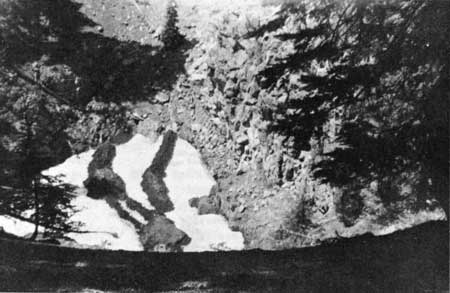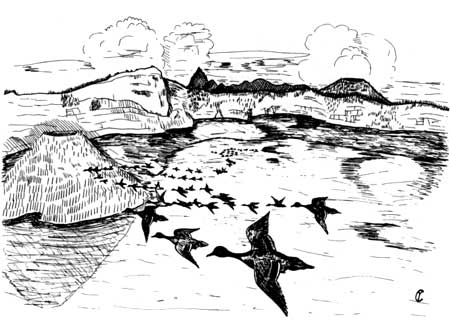|
Volume XVIII - 1952
Snow Crater - Nature's Calendar
By James Richards, Ranger
Snow Crater is a unique and interesting feature of Crater Lake
National Park. It is located in the summit of Scoria Cone in a remote
section of the Park near the South Boundary. It may be reached by
traveling about one and a half miles on the Red Blanket Motorway, and
then about one and a half miles in a southeasterly direction. Regardless
of the heat of the summer season, the snow that has fallen in this
crater from the previous winter never entirely melts; thus over a period
of years a sizable mass of snow has accumulated in the depression at the
top of the cone. It is particularly interesting to note that a season's
accumulation of snow in the crater constitutes a distinct layer, clearly
demarked from the younger layers above and the older layers below.
The layers or "varves" of snow remind one of the varves that are
often deposited by lake waters and from which it is possible to learn
much regarding the time and conditions during which the lake existed.
Varves deposited by a lake consist of alternating layers of dark and
light sediments. During the summer, the life in a pond or lake is on the
increase because of good growing conditions, and likewise, is on the
decline in late fall and winter. As winter approaches and organic matter
dies, it settles and turns dark, thus creating a dark layer of sediment.
During the colder months, the sediments laid down are of an inorganic
nature and much lighter than the previous ones. Thus one layer of both
dark and light constitutes the sediments laid down during a one- year
period and gives rise to a single verve from which a geologist may read
certain facts regarding the conditions prevailing in the lake during the
deposition.
The accumulation of snow and debris in Snow Crater here in the Park
is in many respects analogous to the formation of the varves of a lake.
Each winter brings about an accumulation of snow. and then during the
summer, a layer of rocks, dirt, and debris from the trees forms on top
of the snow. In this manner there is developed a "snow verve,"
representing one year of deposition.

Looking into Snow Crater from the summit of Scoria Cone
about fifty feet above the surface of the snow. The streaks are mud
that has washed over the snow from heavy rains.
As far as I have been able to determine, Snow Crater has been
visited only about four times since 1948. During 1948, Rangers William
Kinsley, Richard Marquis, and a third person visited the Crater at least
twice. On the second trip, an exploration was made in a crevice between
the snow and the rock wall and, according to the report of Ranger
Marquis, about 75 snow varves were counted, representing as many years
of snow accumulation. In 1949 Ranger Kinsley and I visited Snow Crater
but we were unable to make any further studies because of the unusually
heavy snowfall of the preceding winter. During the summer of 1952 I was
able to make a second trip to this remarkable crater. The accompanying
photograph was taken at that time. The near record snowfall of the
1951-52 winter had hidden all of the possible exposures at which the
snow varves might have been counted. It seems very possible that further
exploration will be fruitless until perhaps mid-September, barring an
early winter.
Snow Crater is one of the many out-of-the-way features of Crater
Lake National Park rarely visited by any of the thousands of individuals
who come to the Park each summer. I hope that this Nature Notes
article will serve to call this interesting accumulation of snow to the
attention of hikers and those who are interested in geology. I am sure
that there are many Park visitors who will find a trip to Snow Crater a
fascinating experience.

A flight of Pintails as seen from Sinnott Memorial. Pen
and ink sketch by Ranger-Naturalist Charles F. Yocom.
American Pintail On Crater Lake
By Charles F. Yocom, Ranger-Naturalist
Although many ornithologists have investigated the bird life of
Crater Lake National Park over a period of years, only one sight record
for the American pintail (Anas acuta tzitzihoa) had been recorded
until this season. Farner (1952) states that J. C. Wright, fireguard on
Mount Scott, on August 22, 1949, observed a flock of 20 to 30 Pintails
flying southward toward Upper Klamath Lake.
From July 28 to August 3, 1952, several hundred waterfowl were seen
on Crater Lake or flying out over the rim of this lake by ranger
naturalists. Apparently most of these ducks were Pintails, for all
flocks seen by the writer at close range were this species. The
following records indicate the large number of waterfowl that were
seen:
| Date | Number |
Location | Observer |
| AM 28 July | 100 | on surface near Phantom Ship | D.S. Farner |
| AM 30 July | 1 flock | on surface out from Sinnott Memorial | Robert Wood |
| AM 31 July | 2 flocks | near Rim Village flying south | Warren Fairbanks |
| AM 1 August* | 150 | near Wizard Island | C.F. Yocom |
| AM 1 August | large flock | east of Wizard Island | C.F. Yocom |
| AM 2 August | 60 | near Wizard Island | C.F. Yocom |
| PM 2 August* | 200-500 | feeding and flying near Garfield Peak | Yocom and Farner |
| PM 2 August | 300+ | feeding west of Phantom Ship | Yocom and Farner |
| AM 3 August* | 200 | flying near Sinnott Memorial | Robert Wood |
| AM 3 August | 200+ | on surface out from Sinnott Memorial | Robert Wood |
| PM 3 August | 3 flocks | far out in lake | C.F. Yocom |
| PM 3 August* | 800+ | beyond Wizard Island | D.S. Farner |
*These flocks were identified as Pintails. The large flock seen by
Farner and the writer on August 2 flew very close and were seen under
favorable light so that unmistakable markings were seen.
These flocks of Pintails were undoubtedly migrants that are known to
pass through Washington and Oregon and arrive in California during the
last of July and the first part of August. This early flight of Pintails
is not understood by waterfowl biologists in the Pacific flyway, but
banding will assist in unraveling this problem. There are many later
flights of Pintails as indicated by Yocom (1951). As a matter of fact
the writer has seen migrating Pintails 465 nautical miles west of Cape
Blanco, Oregon, on August 30, 1945.
It is not unusual that Pintails should pass over Crater Lake
National Park in migrating, but it is unusual that large flocks alighted
on the lake and remained for some time, as Pintails are pond ducks which
normally feed by means of tipping in shallow marshes and lakes. Flocks
observed on Crater Lake appeared to be feeding. They remained in
close-knit bunches and swam over the surface quite rapidly, often times
flying a short distance, then milling about in compact groups. Evidently
these birds were securing some desirable food items on the surface of
the lake.
No large flocks of ducks were seen after August 3rd except a flock
of over 100 individuals noted on the Lake east of Wizard Island on
August 17, by D. S. Farner. The birds observed leaving the Lake flew out
over the Rim between Sun Notch and The Watchman, going toward Klamath
Lake and it is believed that all of the flocks seen between July 28 and
August 3 passed on South.
References
Farner, Donald S. 1952. The Birds of Crater Lake National
Park. University of Kansas Press. IX + 200 pp.
Yocom, Charles F. 1951. Waterfowl and Their Food Plants in
Washington. University of Washington Press, Seattle, Washington. XVI
+ 272 pp.
| 
